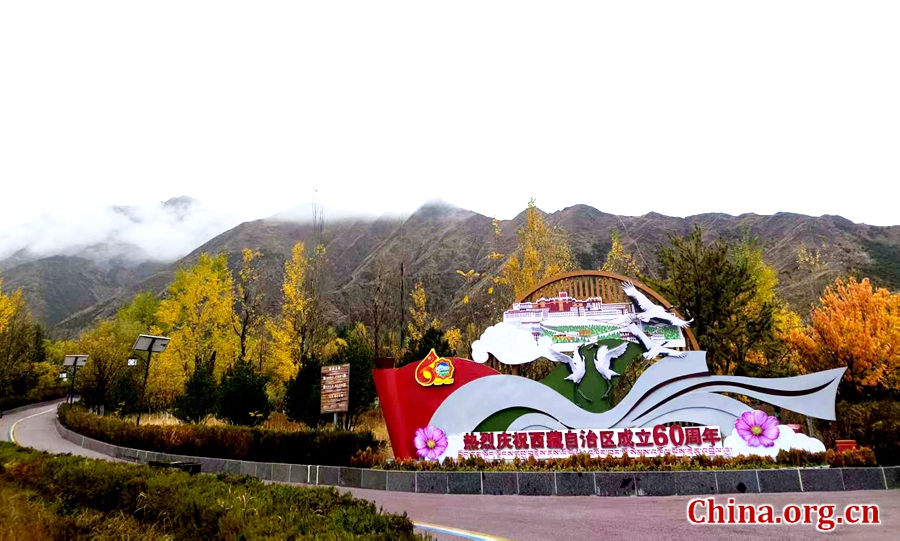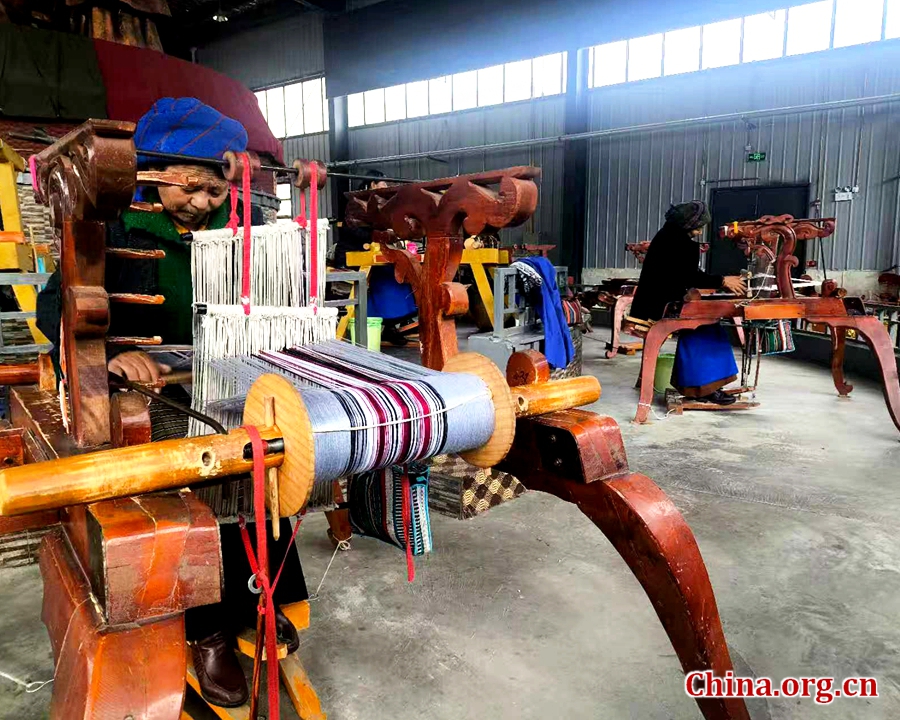

中国网手机版
扫码即可查看网页

On the vast plateau of southwest China's Xizang autonomous region, many changes are taking place— in the slow-growing saplings on once-barren hillsides, in the steady rhythm of the looms and in the laughter shared by neighbors speaking different tongues. Together, these moments tell the story of Xizang— a region where green development, cultural preservation and social harmony intertwine to shape a more prosperous and inclusive future.
Planting hope on the mountains

Nanshan Park in Lhasa, Xizang autonomous region, Nov. 1, 2025. [Photo by Xu Xiaoxuan/China.org.cn]
High above Lhasa, the slopes of the southern and northern mountains now shimmer with shades of green. This transformation is part of Xizang's first large-scale mountain afforestation project— the greening of the northern and southern mountains flanking the Lhasa River. Launched in 2021, the campaign aims to restore 2.07 million mu (about 138,000 hectares) of land across 13 counties in Lhasa and Shannan within 10 years.
The challenge has been immense. The plateau's thin air, short rainy season and steep terrain once made planting trees seem impossible."In the past, people carried seedlings on their backs or by mule," recalled Jiang Wanjie, deputy head of the Lhasa Forestry and Grassland Bureau."Now we use drones to transport seedlings, spray pesticides and deliver irrigation pipes." To improve survival rates, all introduced species are first acclimatized in Lhasa, with soil enriched by organic fertilizers to create better growing conditions for the young trees, Jiang added.
Forester Zhaxi Qupei has seen the changes firsthand. Since 2012, he has planted over 10,000 trees, witnessing barren slopes transform into lush forests. With a drone license and training in automatic irrigation, he now waters a thousand trees a day."Technology makes us faster, but our duty to nature stays the same," he said."I hope Lhasa and Xizang become more and more beautiful."
Today, more than 120 million trees have been planted with an impressive 85% survival rate. The new forests have brought back wildlife— snow leopards, Tibetan foxes and black-necked cranes— and created over 9.5 million work opportunities, adding more than 3 billion yuan (about $421 million) to local incomes. Once completed, the project is expected to store 49.8 million metric tons of water annually, sequester 22,910 metric tons of carbon and generate an annual ecological value of 1.485 billion yuan.
Weaving the past into the future

Locals weave fabric on looms in Zedang town, Shannan, Xizang autonomous region, Nov. 1, 2025. [Photo by Xu Xiaoxuan/China.org.cn]
That same balance between tradition and modern life is being woven in the town of Zedang town in Xizang's Shannan city. Here, a group of workers sit behind wooden looms producing Zetie'er, a unique local handwoven wool fabric that dates to the 7th century, when Princess Wencheng of the Tang dynasty (618-907) introduced new weaving techniques to the region.
For Basang, an inheritor of this national intangible cultural heritage, preserving the craft means more than just keeping a skill alive. Originally a thangka painter, he later realized that only a few elderly locals still knew how to weave Zetie'er. He then decided to change path to protect this remarkable folk art and cultural legacy.
In 2008, Basang founded the Zetie'er Hand-woven Cooperative with seven villagers, learning from five artisans aged over 80. Today, the cooperative employs 127 people, including 79 relocated residents and 32 people with disabilities. In 2024, its output value reached 8.6 million yuan, with profits exceeding 2.4 million yuan.
For 54-year-old Dawa Yangjin, weaving offered hope after hardship. Due to illness, she lost sensation in her right leg and walks with a crutch. Her husband left, and her child passed away. She joined the cooperative in 2013."They trained us, gave us food and accommodation," she said."I feel happy working here, earning nearly 4,000 yuan a month for about 40 hours a week."
Through exhibitions and hands-on workshops, the cooperative invites visitors to learn about the handicraft and even purchase locally-made products— ensuring that the tradition not only survives but thrives as part of Xizang's modern economy.
Living together in many tongues
In Lhasa's Lugu Community, the threads of diversity are woven into everyday life. Home to more than 7,000 residents from 11 ethnic groups— including Tibetan, Han, Hui, Uygur, Mongolian and Yi— it has become a living example of unity in diversity.

Ethnic handicrafts on display in the bilingual classroom in Lugu Community, Lhasa, Xizang autonomous region, Nov. 1, 2025. [Photo by Xu Xiaoxuan/China.org.cn]
The community's streets are lined with more than 400 shops selling local specialties, clothing and handicrafts. Because of the mix of ethnicities among the merchants, communication has become an important part of daily life. Community worker Danzeng Zhuoma said:"Some non-local shopkeepers don't speak Tibetan, and local residents don't speak Mandarin. Every Thursday, we organize bilingual classes— merchants learn Tibetan, and residents learn Mandarin to improve communication."
Community residents often celebrate different festivals together, learning about each other's traditions and picking up simple phrases in each other's languages along the way.
Each tree planted, each thread spun and each word exchanged in different languages marks a step toward a common goal— a greener, more harmonious plateau where the spirit of the people grows as vibrantly as the land itself— a vivid reflection of Chinese modernization, stressing harmony between people, culture and nature.